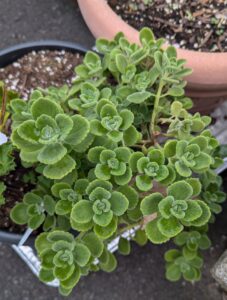 When many people see or hear the word “cerveza”, they think of a cold bottle of beer, as in “cerveza fria”. Since it is now high summer, some people think of that a lot—in Spanish or in English. When I think of “cerveza”, I summon a picture of my back garden, where a healthy ‘Cerveza and Lime’ plectranthus is happily spreading its branches over the edge of a cast concrete planter box and into the great beyond.
When many people see or hear the word “cerveza”, they think of a cold bottle of beer, as in “cerveza fria”. Since it is now high summer, some people think of that a lot—in Spanish or in English. When I think of “cerveza”, I summon a picture of my back garden, where a healthy ‘Cerveza and Lime’ plectranthus is happily spreading its branches over the edge of a cast concrete planter box and into the great beyond.
T.S. Eliot, in his Old Possum’s Book of Practical Cats, said, “The naming of cats is a serious matter.” The naming of plants is a serious matter too, since the success of a particular new variety or hybrid may be at least partly dependent on its name. ‘Cerveza and Lime’ is a hybrid of Plectranthus amboinicus, known in some circles as “Mexican mint”. When the horticultural marketers were tossing around names for this particular specimen, they undoubtedly took into account its cool, lime green leaves and combined that idea with its Mexican common name. That combination, possibly coupled with thirst, made them think of the way that some Mexican beers are served—with a lime wedge–and that resulted in the new hybrid being named ‘Cerveza and Lime’.
Or at least that is what I suppose might have happened. Given our market-driven world, it is also possibly that Dos Equis underwrote the hybridizing efforts. We may never know.
The parent plant, Plectranthus amboinicus, has many evocative nicknames, in addition to “Mexican mint”. In its journey through various places and times, it has been called: “Caribbean Oregano”; “County Borage”; “Cuban Oregano”; “French Thyme”; “Indian Borage”; “Indian Mint”; “Soup Mint”; Spanish Thyme; and “Vick’s Plant”. The significant thing about all these names is that most of them affirm Mexican mint’s membership in the large mint or Labiatae family, home to many aromatic genera, including culinary thyme, and oregano. Plectranthus is also closely related to ornamental coleus, and shares some of coleus’ decorative qualities.
As some of the common names suggest, Mexican mint has been used in cooking, but is not clear that ‘Cerveza and Lime’ can be included in culinary preparations. It is best to err on the side of caution and enjoy the plant as an ornamental.
‘Cerveza and Lime’ grows 14 to 18 inches tall, with an eight to 12 inch spread, bearing leaves that are positioned in opposing pairs on the stems. Those leaves are soft—covered with the finest of hairs–and rounded with lightly scalloped edges. The pervasive fragrance, exuded when you rub the leaves, has notes of oregano, eucalyptus and camphor. Depending on your nose, the odor may remind you a little of Vick’s VapoRub—hence the “Vick’s” common name.
Like all mints, ‘Cerveza and Lime’ is fast growing. I took a cutting from my parent plant and three days later I could not tell where on the plant it had come from. New growth shoots out from the parent like tentacles, making it ideal for container or hanging basket culture. If the plant starts to look ungainly, trim it back to an appealing size and root the cuttings in a glass of water. They will sprout roots in a hurry and will be ready to pot up within a week. Friends who have received the offspring of my ‘Cerveza and Lime’ have thanked me for the gift of this fragrant and appealing plant.
Mexican mint is native to parts of Africa, India and Madagascar, so it will not survive winters in cold weather climates. It is easy to overwinter containerized specimens. Bring the containers indoors when night temperatures start to hover in the fifties, and place on a sunny widowsill. The plant may pout for a short time, but will rebound quickly. Water when the top of the soil feels dry.
Like its namesake liquid, ‘Cerveza and Lime’ is cool and refreshing. And it goes the average cerveza one better, appealing to taste, touch, smell and sight. It is marketed as part of the “Proven Winners” line of plants and is most likely available at a garden merchandiser near you.
